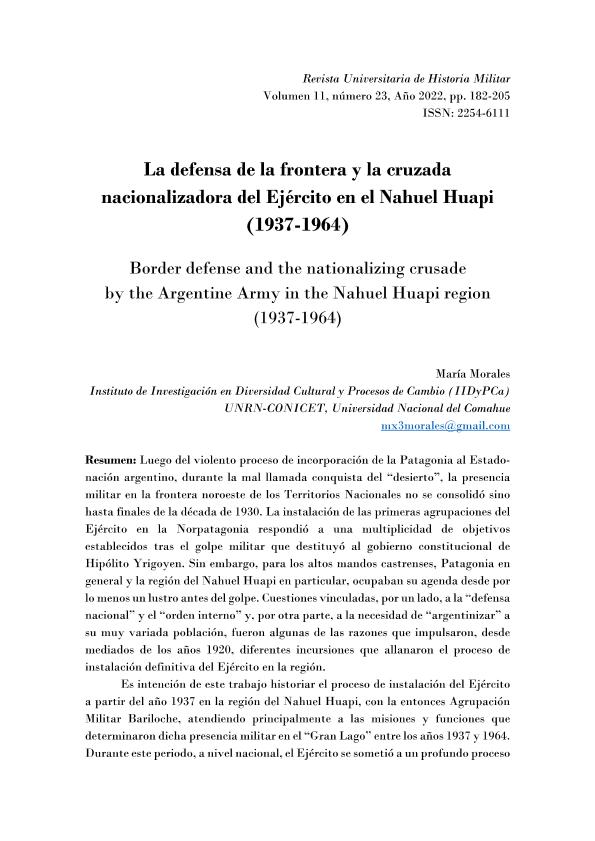Mostrar el registro sencillo del ítem
dc.contributor.author
Morales, María Marta

dc.date.available
2024-04-05T13:01:26Z
dc.date.issued
2023-03
dc.identifier.citation
Morales, María Marta; La defensa de la frontera y la cruzada nacionalizadora del Ejército en el Nahuel Huapi (1937-1964); Centro de Estudios de Historia Militar; Revista Universitaria de Historia Militar; 11; 23; 3-2023; 182-205
dc.identifier.issn
2254-6111
dc.identifier.uri
http://hdl.handle.net/11336/232105
dc.description.abstract
Luego del violento proceso de incorporación de la Patagonia al Estado-nación argentino, durante la mal llamada conquista del “desierto”, la presencia militar en la frontera noroeste de los Territorios Nacionales no se consolidó sino hasta finales de la década de 1930. La instalación de las primeras agrupaciones del Ejército en la Norpatagonia respondió a una multiplicidad de objetivos establecidos tras el golpe militar que destituyó al gobierno constitucional de Hipólito Yrigoyen. Sin embargo, para los altos mandos castrenses, Patagonia en general y la región del Nahuel Huapi en particular, ocupaban su agenda desde por lo menos un lustro antes del golpe. Cuestiones vinculadas, por un lado, a la “defensa nacional” y el “orden interno” y, por otra parte, a la necesidad de “argentinizar” a su muy variada población, fueron algunas de las razones que impulsaron, desde mediados de los años 1920, diferentes incursiones que allanaron el proceso de instalación definitiva del Ejército en la región.Es intención de este trabajo historiar el proceso de instalación del Ejército a partir del año 1937 en la región del Nahuel Huapi, con la entonces Agrupación Militar Bariloche, atendiendo principalmente a las misiones y funciones que determinaron dicha presencia militar en el “Gran Lago” entre los años 1937 y 1964. Durante este periodo, a nivel nacional, el Ejército se sometió a un profundo proceso183de reorganizaron institucional, al materializarse el proceso de profesionalización iniciado a fines del siglo XIX; mientras que a nivel regional se organizaron e instalaron las tropas de montaña. Es dentro de este contexto que la guarnición barilochense fue determinante para efectivizar la protección del territorio y la frontera, además de colaborar en la “cruzada nacionalizadora” propuesta por el gobierno de facto.A través de la utilización de fuentes producidas por las unidades militares guarnecidas en la ciudad de San Carlos de Bariloche, durante el periodo referenciado, será posible aproximarnos a un primer análisis en cuanto al rol que desempeñó la Agrupación Militar en la región, en relación a la defensa de la frontera y también en el impacto que generó su presencia en la configuración socio-espacial en el Nahuel Huapi y cómo la fuerza militar construyó, a partir de sus acciones, representaciones hegemónicas sobre dicha región.
dc.description.abstract
After the violent process of incorporation of Patagonia to the Argentine nation-state during the so-called conquest of the "desert", the military presence in the northwestern border of the National Territories was not, however, consolidated until the end of the 1930's. The deployment of the first military contingents in Northern Patagonia responded to a variety of goals set after the military coup that ousted the constitutional government of Hipólito Yrigoyen. However, Patagonia in general and the Nahuel Huapi region in particular had been on the agenda of the military high command since at least five years before the coup. Issues related, on the one hand, to "national defense" and "internal order" and, on the other hand, to the need to "Argentineize" its very diverse population, were among the reasons that prompted various military incursions since the mid 1920s, paving the way for the later continued presence of the Army in the region. The purpose of this paper is to describe the process of installation of the Argentine Army from 1937 on in the Nahuel Huapi region, starting with the thencalled Agrupación Militar Bariloche and focusing mainly on the missions and functions that characterised military presence in the "Great Lake" between 1937 and 1964. During this period, the Army underwent a profound institutional reorganization on a national level as a result of the professionalization process initiated at the end of the 19th century, whereas, on a regional level, mountain troops were organized and garrisoned there. It is in this context that the Bariloche garrison became crucial for the protection of the territory and the border, as well as to contribute to the "nationalizing crusade" launched by the de facto government. Via the use of sources such as military units garrisoned in the city of San Carlos de Bariloche during the referenced period, it will be possible to venture a preliminary analysis of the role played by the Agrupación Militar regarding border defense and also its impact in the socio-spatial configuration in Nahuel Huapi, as well as how the military gained, through its actions, hegemonic representations in the region.
dc.format
application/pdf
dc.language.iso
spa
dc.publisher
Centro de Estudios de Historia Militar
dc.rights
info:eu-repo/semantics/openAccess
dc.rights.uri
https://creativecommons.org/licenses/by-nc-nd/2.5/ar/
dc.subject
EJÉRCITO
dc.subject
REGIÓN
dc.subject
ARGENTINIZACIÓN
dc.subject
TERRITORIO
dc.subject.classification
Otras Humanidades

dc.subject.classification
Otras Humanidades

dc.subject.classification
HUMANIDADES

dc.title
La defensa de la frontera y la cruzada nacionalizadora del Ejército en el Nahuel Huapi (1937-1964)
dc.title
Border defense and the nationalizing crusade by the Argentine Army in the Nahuel Huapi region (1937-1964)
dc.type
info:eu-repo/semantics/article
dc.type
info:ar-repo/semantics/artículo
dc.type
info:eu-repo/semantics/publishedVersion
dc.date.updated
2024-04-05T12:29:23Z
dc.journal.volume
11
dc.journal.number
23
dc.journal.pagination
182-205
dc.journal.pais
España

dc.description.fil
Fil: Morales, María Marta. Consejo Nacional de Investigaciones Científicas y Técnicas. Centro Científico Tecnológico Conicet - Patagonia Norte. Instituto de Investigaciones en Diversidad Cultural y Procesos de Cambio. Universidad Nacional de Río Negro. Instituto de Investigaciones en Diversidad Cultural y Procesos de Cambio; Argentina
dc.journal.title
Revista Universitaria de Historia Militar
dc.relation.alternativeid
info:eu-repo/semantics/altIdentifier/url/https://ruhm.es/index.php/RUHM/article/view/786
Archivos asociados
